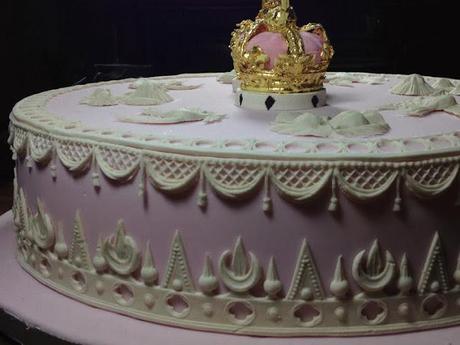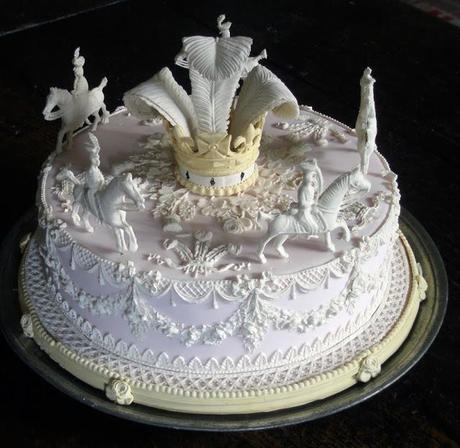
A group of sugar cavalry officers parade round the Prince of Wales Feathers on top of a Regency period twelfth cake
It seems ages since I had enough spare time to post on this blog. Since we are approaching Christmas I thought I would touch on a somewhat seasonal theme. On some of my recent courses I have been teaching my students how to make and decorate twelfth cakes and include some illustrations of their efforts here.Some dishes are frequently mentioned in literary and historical records well before any recipes for them appear in the cookery books. A striking example of this is the twelfth or wassail cake, once commonly consumed on the Feast of the Epiphany on the 6th January. Formerly these cakes were made throughout Christendom, with numerous references to them in most European languages. From the Renaissance onwards, there are many tantalising descriptions of them in English sources, but a specific recipe does not appear in a printed cookery book until 1803 (John Mollard, The Art of Cookery).
Although they are first described in the sixteenth century, twelfth cakes were particularly popular in this country between 1750 and 1850, when they were often decorated with sugar or wax figures and other spectacular ornaments. During the Christmas holiday period, city confectioners would dress their windows with these cakes to show off that year's prize creations. Standards of decoration were very high, a fact that should not be too surprising as this was of course Georgian Britain, the age of the Adam Brothers, Chippendale and Josiah Wedgewood, who all set very high levels of accomplishment in the decorative arts. There are plenty of illustrations of twelfth cakes in contemporary books, newspapers, confectioner's trade cards and the cover designs on packs of twelfth day cards, so we have a pretty good idea of what they looked like. They were embellished according to the prevailing aesthetic trends of the period. Some were embellished with one or two crowns, though this was optional and designs varied enormously depending on the caprice of the confectioner.

A twelfth cake with crown from Robert Chambers, The Book of Days, (London: 1869)
Anyone wanting to replicate a twelfth cake nowadays would probably assume that they were ornamented with royal icing applied with a piping bag. But in the eighteenth and early nineteenth century when this cake was at its apogée, piping had not yet been introduced into England and another, entirely different mode of decoration was used.This was a technique which employed a material called gum paste, made with a mixture of gum tragacanth and powdered sugar blended into a porcelain-like paste with a little water. Gum paste ornaments were pressed out of very finely carved wooden moulds and stuck onto the cake with royal icing, gum water or isinglass.The moulds, sometimes called 'boards' or 'cards' were often carved by the confectioners themselves. Frequently the standard of carving was that of a virtuoso. Although they were used for all sorts of purposes, such as the construction of sugar pieces montées and other table decorations, many of these moulds were carved with motifs specifically intended for ornamenting twelfth cakes. I own two that were intended for making sugar crowns and one other which allowed a confectioner to construct a three-dimensional Prince of Wales Feathers complete with crown.
An eighteenth century boxwood mold which allows a three dimensional crown to be made up out of various components

Two sugar paste crowns made from the mold above in the process of being gilded

A twelfth cake made by students on my Confectionery and Sugarwork Course

An early nineteenth century gum paste mold for making a crown

These two feathers are on the back of the mold indicating that it was used for making the Prince of Wales feathers

Two feathers pressed from the mold. To create the curled effect, the feathers are stuck back to back, wired and furled round a small confectioner's rolling pin

This is a close-up of a very finely carved Prince of Wales Feathers motif on a card mold from the late eighteenth century. It was used as a repeating relief motif in the top of the cake below

Dominated by the Prince of Wales feathers, this twelfth cake has been ornamented with motifs pressed in gum paste from late eighteenth and early nineteenth century confectioner's moulds. The crown is surrounded with the national flowers of England, Scotland and Ireland and small relief Prince of Wales feathers.

An eighteenth century card mold used to create the swags and drops around the cake. It also provided the flowers of England, Ireland and Scotland for the top of the cake

Difficult to see in this photograph, but the saddle covers on these horses are marked with GR. They probably date from the early 1820s. Attached back to back gum paste pressings of the two motifs were designed to be combined to make a three dimensional cavalry officer. Like most of these three dimensional features a stiff wire was run up one of the legs so the horse and rider could be attached securely to the cake.

A detail from an early nineteenth century confectioner's trade card showing a twelfth cake surmounted by figures
There are some other posts on twelfth cakes on this blog which you might enjoy reading -A Forked Stick for the Cookold
This Year's Twelfth Cake
